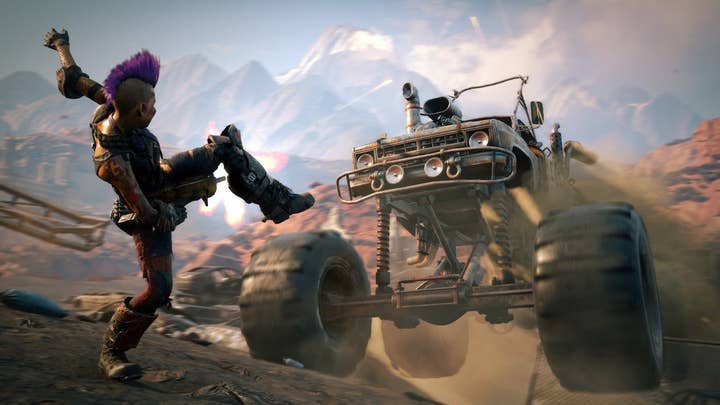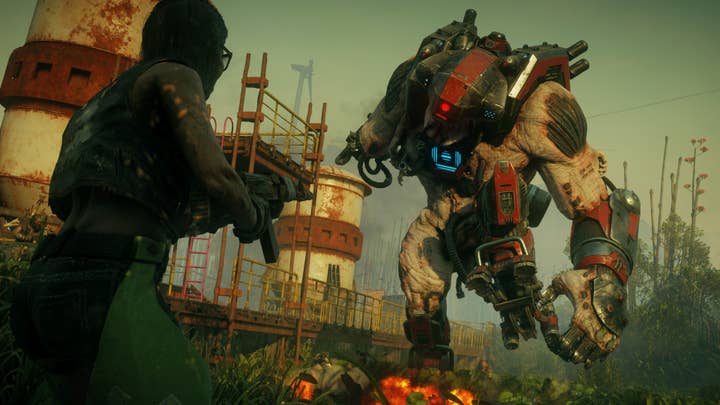Critical Consensus: Rage 2
Bethesda, id Software and Avalanche Studios team up for a potentially brilliant shooter adrift in a largely pointless open-world
As a developer of games, Bethesda marries critical praise and massive commercial appeal like few other companies. As a publisher of games, however, it tends to hit one or the other, and mostly the former.
Series like Dishonored and The Evil Within have loyal audiences, but neither has electrified the market in the way they do their fans. Wolfenstein and Doom have been more obvious commercial hits, but they were likely slower out of the gate than Bethesda could have expected based on the weight their names carry.
It was no great surprise that Bethesda's E3 press conference last year closed on what amounted to mere glimpses of what's coming next from Bethesda Game Studios. Even with three to four major releases each year as a publisher, the question on the vast majority of lips is the same one that has lingered for nigh on a decade: "When's the next Elder Scrolls?"
"If you're playing Rage 2 for the plot, you're probably doing it wrong"
USGamer
There were other games onstage that day, of course, one of them a sequel to Bethesda's best hope at establishing a major original IP in the last ten years: Rage, which Bethesda launched two years after its creator, id Software, was acquired by ZeniMax Media in 2009. It was the next game in a lineage that included Wolfenstein, Doom and Quake, and it should have been huge. Instead, both its scores and its sales fell below the standard generally expected from AAA blockbusters, to the point where some may be surprised that a sequel was made at all.
Indeed, that very sentiment is expressed in many reviews of Rage 2. USGamer's Mike Williams described it as "the unlikely sequel to Rage," an eight year-old game that "felt more like a tech showcase" for id Tech 5 even back then. With Avalanche Studios onboard as a co-developer this time, though, it seemed clear that Bethesda understood the flaws in the first game, and was taking drastic steps to address them.

In theory, at least, Rage 2 should be a balance of Avalacnhe's strength with chaotic, reactive open-worlds, and id Software's peerless knack for shooter mechanics. In reality, the critics seem to agree that Rage 2 is pretty much that and not much more.
"Surprisingly, it mostly worked," Williams noted of the union between Avalanche and id. "There is a story, and there are characters, but they're really not the point. Of the three major characters that help you, each only has two primary missions a piece before you get what you want from them. There's a level gate in place, where you have to reach a specific project level with them to proceed to the second mission, but on two of the characters, I had nearly crossed that threshold before meeting them.
"Each weapon looks, feels, and sounds perfect, even before I upgrade and modify them"
Polygon
"I hit the point of getting the main campaign's final mission at around 12 hours, and I polished it off at around 15 hours... If you're playing Rage 2 for the plot, you're probably doing it wrong. Instead, Rage 2 is all about the combat and exploration."
The excellence of the combat is one thing that every single critic agrees on. At the time of writing, the Metacritic scores for Rage 2 range from 68 (Xbox One) to 75 (PlayStation 4), and yet the assessment of its action gameplay is virtually faultless across the board.
Polygon's Ben Kuchera described Rage 2 as, "so satisfying in action, so totally shameless, that I find it hard to put down. I could list the game's inadequacies and describe its bizarre menus or upgrade structure all day long, but the more I talk about the game the more I find myself preferring to play it instead."
Rage 2 doesn't reward deep rumination on its premise, its story or its characters, Kuchera said, and its world is only open in the loosest sense. This game is structured to be, "a linear, relatively short Doom-style single-player game that is only cosplaying as an open world title." However, it is also one that can be deliriously fun to play.

"Each weapon looks, feels, and sounds perfect, even before I upgrade and modify them. Using the shotgun's secondary attack to send mutants flying through the air is fun in the first hour of the game, and it remains fun by hour ten. Sure, it's not always effective, but it lends itself to experimentation. Can I complete an entire area by knocking enemies off high ledges, sending them to their doom below? I can certainly try!
"It's a testament to the quality of the game's combat that it's able to redeem so many of the game's less inspired choices. The worst parts of Rage 2 aren't tedious or distracting. They're merely competent. That's fine, considering the best parts of Rage 2 are damn near transcendent."
"It presents a vast, uninspired apocalyptic wasteland crammed with repetitive activities"
The Guardian
The Guardian left Rage 2 with a similarly conflicted view, awed by its "scintillating action" but ultimately confused by the decision to set it in an open-world at all. According to critic Rick Lane, that choice saps the very precision that its varied, rewarding combat demands.
"If Rage 2 had built these systems into a more traditional shooter structure, with intricate levels designed to maintain a snappy pace, then it may have been one of the year's highlights," Lane said. "Instead, it presents a vast, uninspired apocalyptic wasteland crammed with repetitive activities. You'll need to destroy mutant dens, clear roadblocks, and eliminate bandit camps prowled by gangs such as the Goon Squad, who resemble armed Prodigy fans.
"Although entertaining for the first few hours, these activities wear thin after the 10th or 11th iteration. The strangely inert environment design is miles away from, say, the eerie and haunting atmosphere of the similarly apocalyptic Metro: Exodus. The wasteland doesn't lack detail -- particularly in its handful of towns, which blend rusting corrugated iron with blazing neon signage -- but, aside from buying equipment and checking in on the story, there's little reason to explore these places.
"Rage 2 suffers the same fate as many other open-world games. It tries to lure the player in with the size of its world, then needs to conjure an abundance of content to fill it. But, when you mix up every colour, you always end up with brown, and the impact of Rage 2's scintillating shooter action is dulled as a result."
If some critics found Rage 2's environment lacking in compelling things to do, none missed the clear attempt to infuse the setting with anarchic, grotesque personality. That much has been apparent in its marketing, which has dripped in neon, paint splatter, and screeching mutant punks. Rock Paper Shotgun's review -- which, again, is bowled over by the quality of the action -- refers to moments, "so arrestingly strange or gross that I can't help but stop and stare."
Much of this incident tends to hit the same immature note, Matt Cox observed, but it also yields a handful of striking moments, which are best captured by the game's extraordinary character names.
"If only Rage 2 existed in a vacuum, its every moment might not remind you of the better games that it borrows from"
Vice Games
"Chaz Miraz. Shaniqua Custoblasteroid. Dognbone von Carrotcake. FURIOUS SLASH. Pappy Swift. Andi Wasteland. Dag Satan. OPULENT CHASTITY. Sticko Chew. Zap Boltington. Yin Bonbon. Just Tony. Ratter Tat. Tarty Manymango. Tara Wafflebang. KILL MISTER. Moulder Pus. Smeggo the Vile (bless his slimy secretions). Peely Wally. Long Arms. Short Legs. Gulcho Smegnome. Fab Drumstick.
"Note how some of those are written in capitals. The whole game is, really. Sometimes with poor spelling."
For all that posturing and gurning -- or, as RPS put it, "a lot of thrusting" -- Rage 2 is not the distinctive experience its ornate character names would suggest. Indeed, as Vice Games' Rob Zacny pointed out in his review, one of Rage 2's biggest issues is the way it calls to mind so many other games, most of them superior examples of that specific trait.
"If only Rage 2 existed in a vacuum, its every moment might not remind you of the better games that it borrows from," Zacny said.
"The fast, gracefully violent combat would feel like a welcome return to the classic shooter formula that id Software pioneered and perfected across the 1990s, except that we already experienced this back in 2016 with the new edition of Doom which, frankly, did it better. Driving across the broken desert wastelands in armored muscle cars, shooting it out with roving enemy convoys, is kind of novel but it's also a pale shadow of what Avalanche Studios accomplished in its own Mad Max game in 2015. The entire campaign structure, where you bounce between a map covered in activities and hub locations where you get mission from thinly-written goofball characters, is reminiscent of the modern Far Cry series in all the wrong ways and few of the good ones.
"But if you can set all that aside, or you don't have all that context, it's not so bad. It's very much the sum of its many decent parts minus the sum of its many mediocre or bad ones."


